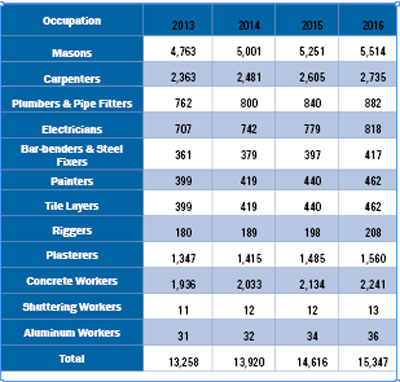Labour shortage pertinent issue in construction
Sri Lanka’s construction sector has experienced rapid growth from 2005 to 2015 in terms of its workload, but there isn’t much to say on the structured development addressing the human resources needs demanded by this rapid growth.
The organisational development and capacity of the industry to address these needs have been lacking, resulting in companies being unable to retain skilled employees and attract new employees to fulfil growing demand, industry analysts say.
Working conditions
The construction industry presents a harsh, more rigorous and dangerous work environment than most other sectors of the economy. Construction workers generally have to endure long working hours, expose themselves to unpredictable and (often) harsh weather conditions together with frequent travel (from different locations within one project or from project to project), a construction engineer said.
In Sri Lanka the training of construction industry craftsmen is mainly carried out by several training institutions, which belong to the public and private sector.
The public sector training institutions are the Vocational Training Authority (VTA), National Apprentice and Industrial Training Authority (NAITA), Department of Technical Education and Training (DTET), and the Institute of Construction Training and Development (ICTAD). In addition, there are a few private sector training institutions such as the Chamber of Construction Industry Sri Lanka (CCI), Sanken Construction, Maga Engineering, Jayalath Construction Equipment Training, etc. These institutions have their own curriculum prepared for six to 18 month training courses.
 Data shows that as of 2009, the direct employment in the construction industry was 562,000 persons. “This included four categories of employees: professional, technical, crafts, and machine operators. Almost 97 per cent of total persons employed were males with 75 per cent falling in the 25-45 age-group. Some 52 per cent were with experience of less than five years,” an analyst who has done research on this said.
Data shows that as of 2009, the direct employment in the construction industry was 562,000 persons. “This included four categories of employees: professional, technical, crafts, and machine operators. Almost 97 per cent of total persons employed were males with 75 per cent falling in the 25-45 age-group. Some 52 per cent were with experience of less than five years,” an analyst who has done research on this said.
This isn’t enough
As per the report titled “Skills Gap in Four Industrial Sectors in Sri Lanka” published by the International Labour Organisation in 2015, the additional annual requirement of craftspeople in the construction sector is estimated to be 15,000.
The major reasons for the labour shortage include harsh working conditions, social stigma, availability of alternative and foreign employment, lack of adequate training infrastructure and/or the inability to these training institutions to attract trainees, the engineer added.


